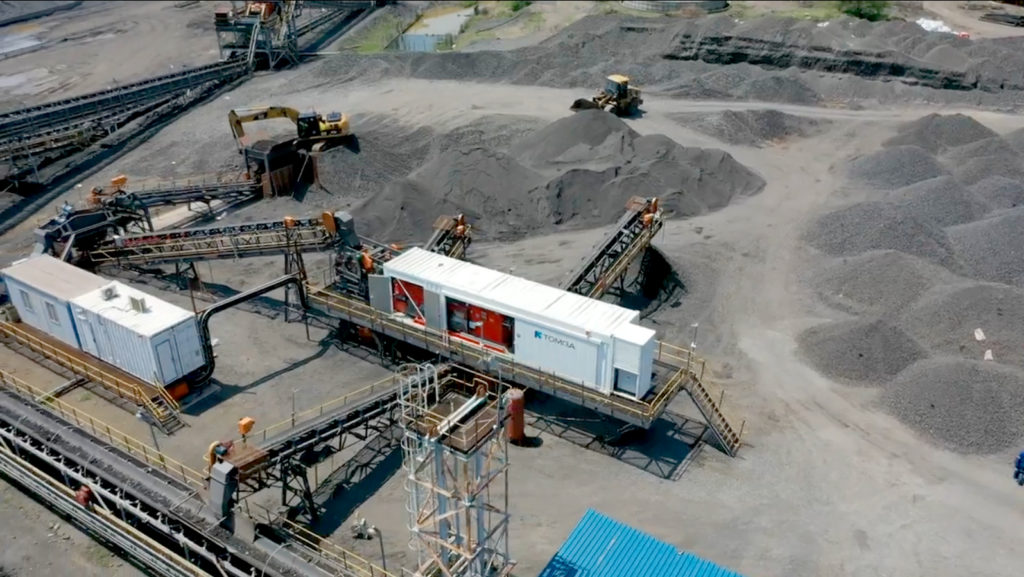One of TOMRA’s X-ray Transmission (XRT) sensor-based ore sorters is helping improve recoveries and lower costs at a South Africa chrome operation.
As South Africa chrome mining operations have increased production in the face of rising demand from stainless steel buyers, the cost of using traditional methods for separating low-grade chromite material, such as dense media separation (DMS), cyclones and spirals, has increased. XRT ore sorting, an established technology in physical separation that has proved extremely effective in mining operations for a variety of minerals, including chrome, is another pre-concentration route they are looking into.
“Its benefits are significant: less complexity in the process, considerably lower costs, higher productivity and profitability – and the added advantage of a lower environmental impact,” TOMRA, a supplier of XRT solutions, said.
The X-ray sensor accurately establishes the density of each particle in the feed, and high-speed pneumatic ejectors separate ore with high chromite content from barren or low-grade ore at throughputs between 60-200 t/h. “The resulting output is a high-grade product that is ready to sell, with no need for additional comminution,” the company said. “It is a dry process that requires no water or reagents, and is frugal in its energy consumption, resulting in a fraction of the capital expenditure and running costs of traditional methods, as well as a smaller footprint.”
Engineering and project management company P2E Consulting has first-hand experience of the advantages of TOMRA’s XRT technology in sorting chrome ore at Eastern Chrome mines, in South Africa. It was looking for a solution to improve the efficiency of the sorting plant and turned to TOMRA.
“We have installed TOMRA sorters on diamond and copper plants in the past and we believe their technology is ahead of their competitors,” Craig Meadway, Business Development Executive of P2E Consulting, said.
P2E Consulting commissioned a TOMRA COM XRT 2.0 sorter to replace an existing drum DMS plant.
“The mine used the DMS plant to produce saleable small lumpy product from the mine’s LG6 Chromite run of mine and dumps at a minimum grade of 38%, but it was very inefficient,” Meadway explains. “The TOMRA XRT sorter has resolved this issue. It is used to upgrade under value material with a head grade of 20-28%, to produce a saleable product at a minimum grade of 38% Cr2O3. It does this efficiently and at a low cost of production.”
The TOMRA COM XRT 2.0 sorter has exceeded Meadway’s expectations, with grades being achieved in excess of 40% Cr2O3 and mass recoveries of 25-30% from scalped waste resulting in chrome-in-tails as low as 12%.
“No other technology has given us such a high recovery rate. Not only that, with TOMRA’s XRT there was no water usage at all, and we didn’t need to spend on expensive reagents, so that we are producing small lumpy product for approximately 50% of the cost compared to a DMS plant,” he said.
The environmental benefits of TOMRA’s XRT solution were also an important factor in P2E Consulting’s choice of technology. “We are looking to introduce greener technologies into the mining industry. The fact that no water or chemicals are used is a major advantage,” Meadway said. “Also, South Africa has major power limitations, and the lower energy consumption when compared to DMS is a huge driving force.”
The ease of operation of TOMRA’s XRT sorters proved to be a further advantage: “It is very easy to use: once the sorter and feed system control philosophy is set up correctly, the plant runs with very little input from the operators,” Meadway said.
TOMRA’s collaborative approach and all-round support was also an important factor in P2E Consulting’s decision to turn to them for this project, according to Meadway.
“We knew from our experience in previous projects that the support from TOMRA is very good, and with the installation of this machine in a relatively new application, it was excellent,” he said. “The local team has bent over backwards to help us make this happen.”











